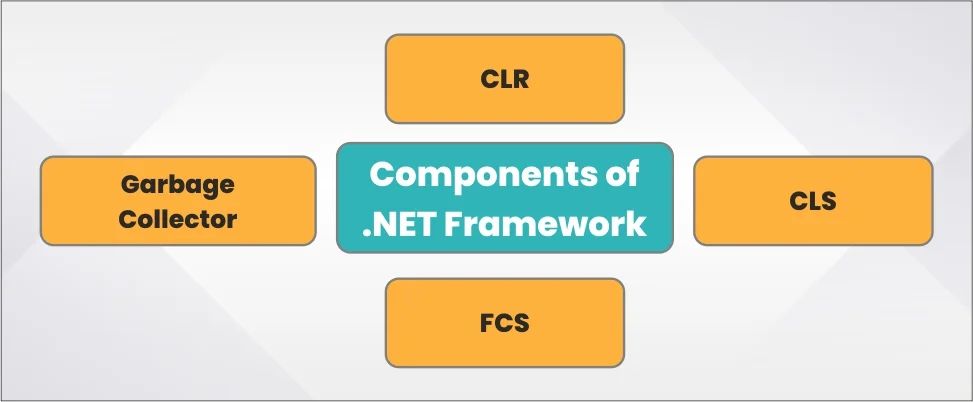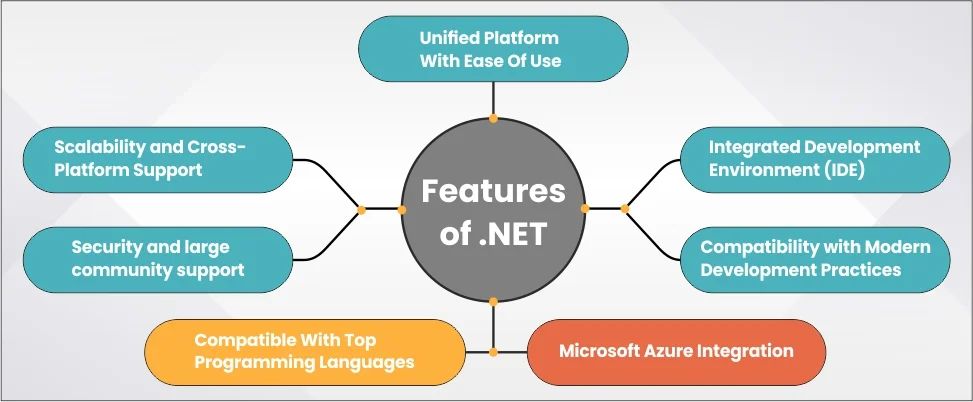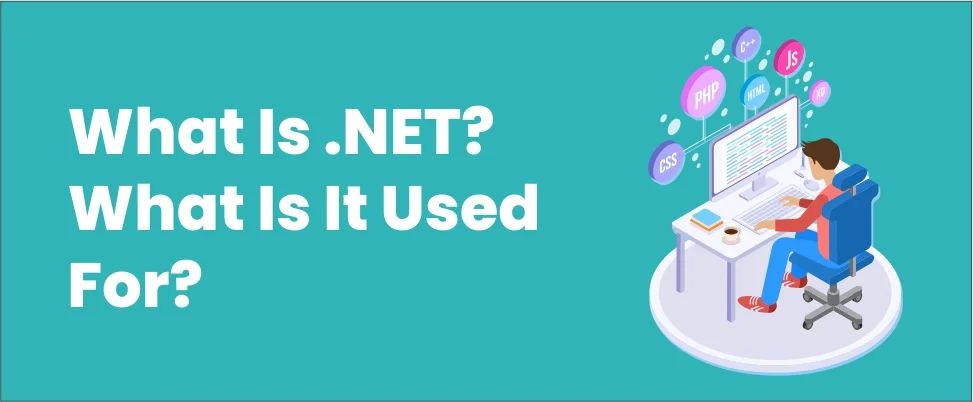Table of Contents
ToggleIntroduction
Of the 26.9 million software developers around the world, there are at least 5-6 million who work with Microsoft .NET to build different applications. Being a Microsoft product, .NET offers a range of compatibility features across other Microsoft products, which makes it a popular choice among businesses and developers. Moreover, .NET is also a free and open-source platform, making it cost-effective. Let’s understand in detail what .NET is and what its uses are in the development world.
What is .Net?
.NET is an open-source, free framework developed by Microsoft for Windows, Linux, and Mac operating systems. Developers can use .NET with different coding languages such as C#, JavaScript, and Python to create applications. Since its launch in 2002, .NET has been helping developers create applications that are used by millions of people on different devices.

Don't miss out on your chance to work with the best
apply for top global job opportunities today!
.NET and its Versions
Microsoft first developed and launched .NET in 2002. It has released many new versions after that periodically, the latest being NET 8.0.0, which was released on November 14th, 2023. Microsoft announces a new major .NET release every year in November. There are two types of releases:
- Long Term Support (LTS)
These releases get support for three years after the initial release.
- Standard Term Support (STS)
These releases are supported for six months after a subsequent STS or LTS release. Releases happen every 12 months, so the support period for STS is 18 months.
| Version | Release Date | Key Features |
|---|---|---|
| .NET Framework 1.0 | Feb-02 | Initial release |
| .NET Framework 1.1 | Apr-03 | Improved ASP.NET support |
| .NET Framework 2.0 | Nov-05 | Generics, ASP.NET AJAX |
| .NET Framework 3.0 | Nov-06 | WPF, WCF, WF |
| .NET Framework 3.5 | Nov-07 | LINQ, ASP.NET MVC |
| .NET Framework 4.0 | Apr-10 | Dynamic Language Runtime, Parallel Extensions |
| .NET Framework 4.5 | Aug-12 | Async programming, ASP.NET improvements |
| .NET Framework 4.5.1 | Oct-13 | Improved diagnostics and debugging |
| .NET Framework 4.5.2 | May-14 | Stability and security improvements |
| .NET Framework 4.6 | Jul-15 | API enhancements, performance improvements |
| .NET Framework 4.7 | Apr-17 | Cryptography improvements, Windows 10 support |
| .NET Core 1.0 | Jun-16 | Cross-platform, open source |
| .NET Core 1.1 | Nov-16 | Performance improvements, new APIs |
| .NET Core 2.0 | Aug-17 | Razor Pages, EF Core 2.0, improved performance |
| .NET Core 2.0 | Aug-17 | Razor Pages, EF Core 2.0, improved performance |
| .NET Core 2.1 | May-18 | SignalR, HttpClient, improved runtime |
| .NET Core 2.2 | Dec-18 | Improved SDK, ASP.NET Core updates |
| .NET Core 3.0 | Sep-19 | Support for Windows Desktop applications |
| .NET Core 3.1 | Dec-19 | LTS release, improved performance and features |
| .NET 5.0 | Nov-20 | Unified platform (.NET Core + .NET Framework) |
| .NET 6.0 | Nov-21 | Long-Term Support (LTS), Blazor updates, MAUI |
| .NET 7.0 | Nov-22 | On-stack replacement, OpenAPI support, Profile-guided optimization |
| .NET 8.0 | Nov-23 | Record types, Improved Pattern Matching |
What Are the Implementations of .NET?
.NET implementations allow developers to execute the .NET code on different operating systems like Linux, macOS, Windows, iOS, Android, and many others. The three .NET implementations are:
| .NET Framework | .NET Core | .NET Standard |
|---|---|---|
| Released by Microsoft in 2002 | Launched in in late 2014 | Announced in August 2000 |
| Supports running websites, services, desktop apps, and more on Windows | Enables cross-platform support for .NET developers | Allows reusing of the same codes and libraries |
What are the Components of .NET?

CLR (Common Language Runtime): .NET Framework includes the CLR, and it helps you execute .NET programs in many supported languages. With the help of CLR, developers can move a program compiled for the CLR to any system with Windows 2000 or Windows XP.
CLS (Common Language Specification): Although the languages supported by .NET use their own syntax for writing code, CLS has a set of features supported by CLR. So, despite the different syntactic rules, CLS helps compilers produce common instructions that allows developers to build verifiable codes.
FCL (Framework Class Library): The FCL comes with its data types, interfaces and built-in classes that have a wide range of compatibility. It is used by all .NET languages, including C# and offers programmers pre-built codes for common tasks, which reduces development time.
With the help of the FCL integration with CLR, developers can use the .NET Framework to perform several functions and build different desktop, mobile, and web applications.
Garbage Collector: Memory allocation and release are two characteristics of this component. It automatically manages memory for applications. Thus, developers don’t need to write codes to perform memory management tasks when working with .NET. This feature efficiently allocates objects on the managed heap. It keeps the memory available for future allocations as objects that are no longer being used are reclaimed.
What Are the Features of .NET?

- A unified platform with ease of use: The .NET platform offers tools, such as the Visual Studio suite, to help developers write code faster and collaborate efficiently. Further, it also allows them to test and fix their code without any hassles. In addition, the launch of .NET 5 offers developers a unified platform. It simplifies the development environment by bringing together .NET Framework and .NET Core. The unified platform that is easy to use can help bring down costs, as .NET allows you to reuse code between implementations.
- Compatibility with top programming languages: .NET is compatible with the three popular Microsoft languages – C#, F#, and Visual Basic. Developers can choose a language that best suits the project they are working on.
- Integration with Microsoft Azure: .NET seamlessly integrates with Azure, Microsoft’s cloud platform. .NET developers who learn to use Azure with .NET can build scalable and reliable applications that can be maintained easily. The integration helps develop end-to-end solutions for businesses and organizations.

- Scalability and cross-platform support: .NET offers the scalability required to handle increasing workloads. It has tools that can help you build both a small business application and a large-scale enterprise system. .NET allows developers to create apps for desktop, machine learning, mobile, desktop, Cloud, and IoT. The platform offers the scalability required to handle increasing workloads.
- Security and large community support: .NET is a Microsoft product and announces regular updates to tackle security threats to the platform. Also, businesses across the world trust Microsoft with their official data. This makes .NET one of the most reliable platforms for millions of developers and businesses. The .NET platform has support from around 5,000,000 .NET developers worldwide. It helps developers and businesses collaborate in this large ecosystem to find solutions to technical challenges.
- Integrated Development Environment (IDE): Microsoft’s Visual Studio is the flagship IDE tool for .NET development. The tool is optimized for building and debugging modern web and cloud applications. It offers other features such as profiling and code analysis, thus improving productivity and streamlining the software development process.
- Compatibility with Modern Development Practices: .NET offers great features, such as microservices architecture and containerization, that are compatible with modern development practices. This makes .NET a great option for developing modern, cloud-native applications.
Interesting Read: Is .NET relevant in 2023? What is its Future Scope?
What is .NET used for?

The .NET platform offers tools, libraries, and languages to help developers create modern, high-performance applications for web, mobile, and desktop across operating systems. Let’s see a few things that can be built using .NET.
- Web applications: You can use ASP.NET Core with Blazor to develop interactive web UIs with C#. ASP.NET Core helps build faster and scalable applications, keeping in mind the standard security protocols. It offers rich features and enables you to work efficiently with front–end tools such as HTML, CSS, and C#. Moreover, the inbuilt security features of ASP.NET protect .NET apps from malicious cyberattacks. Further, ASP.NET Core enables real-time communication between the server and the client. Companies such as Stackoverflow, BurnRate, Vestas, and UPS are a few happy customers of .NET.
- Mobile applications: You can integrate Visual Studio with .NET MAUI to build multi-platform native apps on Windows, macOS, iOS, and Android. The .NET multi-platform app UI allows developers to use a single C# codebase and project system for all device targets to build apps.
You can use open-source platforms such as Xamarin/Mono to run .NET apps on iOS and Android devices. Xamarin, along with .NET, offers consistent user experience across all mobile platforms.
- Desktop applications: .NET MAUI also uses the latest technology to build modern, multi-platform, natively compiled macOS and Windows desktop apps. You can not only develop the apps on Android, iOS, macOS, and Windows but also abstract them into one common framework built on .NET 6 and later versions.
- Game Development: .NET offers tools, programming languages, and libraries necessary to develop games across devices, including mobile, desktop, console, TV, VR, AR, and the web. Earlier, before game developers could use.NET to develop games, they had to write the codes from scratch to create games. Today, with C# growing in popularity, it is possible to run it on NET 5 to build games on many platforms like Android, iOS, Mac, etc. .NET offers tools that work well with game engines to create 2D and 3D games for popular desktops, phones, and consoles.
- Internet of Things (IoT): The cross-platform support offered by .NET allows developers to build IoT applications with C# and .NET that run on Raspberry Pi, HummingBoard, BeagleBoard, Pine A64, and more. The open-source libraries and framework of .NET can interact with specific hardware like sensors, analog-to-digital converters, and LCD devices.
- Microservices: With the microservices architecture, developers can break down large applications into independent, smaller parts. APIs made on ASP.NET can be easily consumed from any application like mobile, desktop, games, and web. Companies like Amazon, Netflix, Uber, and Etsy use microservices to achieve agility, and scalability and earn better revenues.
- Cloud-based applications: With .NET Aspire, you can develop observable, production-ready, distributed applications. This cloud-native stack is easy to use as one simple gesture can be used without complex configuration to run multi-project distributed applications. .NET offers extensive support so that developers can build scalable and flexible cloud-native apps ready for the future. It runs on all major cloud providers like AWS, Google Cloud, and Microsoft Azure.
- Machine Learning: .NET can help you succeed in the domain of generative AI by offering prebuilt AI models to build innovative and intelligent applications. ML.NET helps developers build apps that have emotion and sentiment detection, vision and speech recognition, language understanding, knowledge, and search. Moreover, you can use languages such as F# to build powerful libraries and scalable data integration for data science and machine learning.
The Bottomline
.NET is a free, open-source platform by Microsoft with tools that help developers write faster code for innovative applications. Many start-ups opt for .NET for full-stack web and mobile development using C#. This open-source software platform licensed by MIT comes with built-in tools, offers cross-platform integration and works seamlessly on different operating systems. With Microsoft .NET, you can collaborate, test, and fix codes quickly and efficiently. .NET’s versatility and wide range of applications make it one of the top choices to build faster, secure and resilient applications.
Take control of your career and land your dream job
sign up with us now and start applying for the best opportunities!

FAQs
.NET is a framework with programming guidelines that developers use to build mobile, desktop, and web applications. C#, VB.NET, C++ and F# are some of the programming languages it can work with.
.NET is an open–source platform that allows you to develop web applications and services, desktop apps, and native mobile applications across platforms.
.NET is cross-platform and runs on Linux, macOS, and Windows. However, .NET Framework runs only on Windows.
Although .NET and .NET Framework share many components, unlike NET Framework, NET is cross-platform and runs on Linux, macOS, and Windows.
The .NET platform has tools and libraries that are used by developers to build web, mobile, and desktop applications.
It can be used both at the front-end and back-end. For instance, C# & VB.NET are used for frontend development, and ASP.NET is used as backend.





